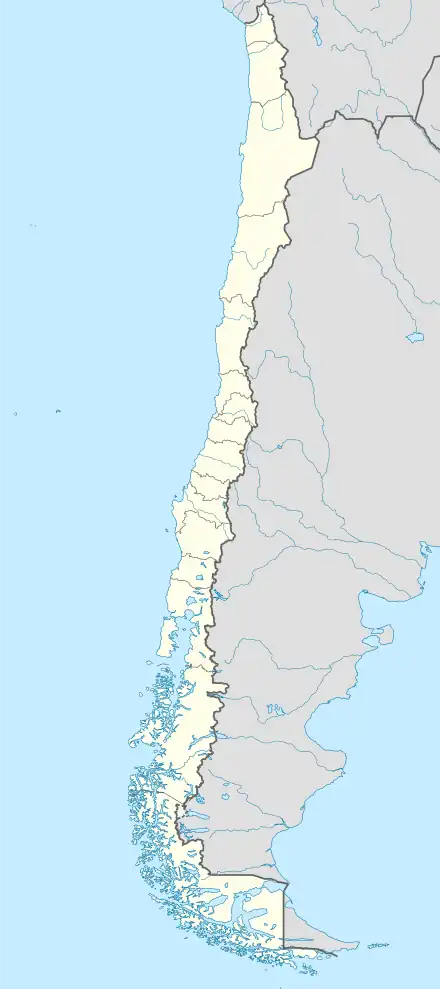Mariquina, Chile
Mariquina is a commune in southern Chile, Valdivia Province, Los Ríos Region. It is located about 40 km northeast of Valdivia, close to Cruces River. The capital is the city of San José de la Mariquina. The commune's main economic activities are agriculture, cattle farming and wood pulp manufacturing.
San José de la Mariquina | |
|---|---|
 Flag  Coat of arms  Location of Mariquina commune in Los Rios Region  Mariquina Location in Chile | |
| Coordinates (city): 39°31′S 72°58′W | |
| Country | Chile |
| Region | Los Rios |
| Province | Valdivia |
| Founded as | San José de La Mariquina |
| Founded | 10 December 1850 |
| Government | |
| • Type | Municipality |
| • Alcalde | Rolando Mitre |
| Area | |
| • Total | 1,320.5 km2 (509.8 sq mi) |
| Elevation | 6 m (20 ft) |
| Population (2012 Census)[2] | |
| • Total | 19,823 |
| • Density | 15/km2 (39/sq mi) |
| • Urban | 8,925 |
| • Rural | 9,298 |
| Sex | |
| • Men | 9,361 |
| • Women | 8,862 |
| Time zone | UTC−4 (CLT) |
| • Summer (DST) | UTC−3 (CLST) |
| Area code | 56 + 63 |
| Website | Municipality of Mariquina |
Demographics
According to the 2002 census of the National Statistics Institute, Mariquina spans an area of 1,320.5 km2 (510 sq mi) and has 18,223 inhabitants (9,361 men and 8,862 women). Of these, 8,925 (49%) lived in urban areas and 9,298 (51%) in rural areas. The population grew by 1.5% (271 persons) between the 1992 and 2002 censuses.[2]
Administration
As a commune, Mariquina is a third-level administrative division of Chile administered by a municipal council, headed by an alcalde who is directly elected every four years. The current alcalde is Ronaldo Mitre Gatica.
Within the electoral divisions of Chile, Mariquina is represented in the Chamber of Deputies by Alfonso De Urresti (PS) and Roberto Delmastro (RN) as part of the 53rd electoral district, together with Valdivia, Lanco, Máfil and Corral. The commune is represented in the Senate during the 2014–2022 period by Alfonso de Urresti (PS) and Ena von Baer (UDI) as part of the 16th senatorial constituency (Los Ríos Region).
History
In the mid-17th century local cacique Juan Manqueante ruled the lands of Mariquina. He presented himself to the Dutch who had arrived in Valdivia in 1643 as a friend.[3] When the Spanish returned in 1645 he allied to them for about ten years until the Mapuche uprising of 1655.[4] Local lore consider him the most notable person ever born in the lands of Mariquina.[4] Manqueante was catholic according to contemporary chronicler Diego de Rosales.[4]
According to Tomás Guevara by the 18th century the Mapuche of Mariquina were among the last to raise chilihueques, a now extinct llama-like animal.[5]
During the Mapuche uprising of 1881 most women of San José de la Mariquina were sent to the city of Valdivia as men prepared for hostilities. Chileans and German settlers dug defensive trenches around the town.[6] At the moment of the uprising it was even thought that rebels could reach Valdivia in the south if they succeeded in penetrating San José de la Mariquina.[6]
References
- "Municipality of Mariquina" (in Spanish). Retrieved 13 December 2010.
- "National Statistics Institute" (in Spanish). Retrieved 13 December 2010.
- Barros Arana 2000, p. 285.
- Alonqueo, Martín (1996). Hidalgo L., Jorge; Schiappacasse F., Virgilio; Niemeyer F., Hans; Aldunate del S., Carlos; Mege R., Pedro (eds.). Culturas de Chile (in Spanish). Vol. 2. Editorial Andrés Bello. p. 232. ISBN 956-13-1437-1.
- Torrejón, Fernando; Cisternas, Marco; Araneda, Alberto (2004). "Efectos ambientales de la colonización española desde el río Maullín al archipiélago de Chiloé, sur de Chile" [Environmental effects of the spanish colonization from de Maullín river to the Chiloé archipelago, southern Chile]. Revista Chilena de Historia Natural (in Spanish). 77: 661–677.
- Vergara, Jorge Iván; Gundermann, Hans (2012). "Constitution and internal dynamics of the regional identitary in Tarapacá and Los Lagos, Chile". Chungara (in Spanish). University of Tarapacá. 44 (1): 115–134. doi:10.4067/s0717-73562012000100009. Retrieved 25 December 2013.
- Bibliography
- Barros Arana, Diego. "Capítulo XI". Historia general de Chile (in Spanish). Vol. Tomo cuarto (Digital edition based on the second edition of 2000 ed.). Alicante: Biblioteca Virtual Miguel de Cervantes.
External links
- (in Spanish) Municipality of Mariquina
